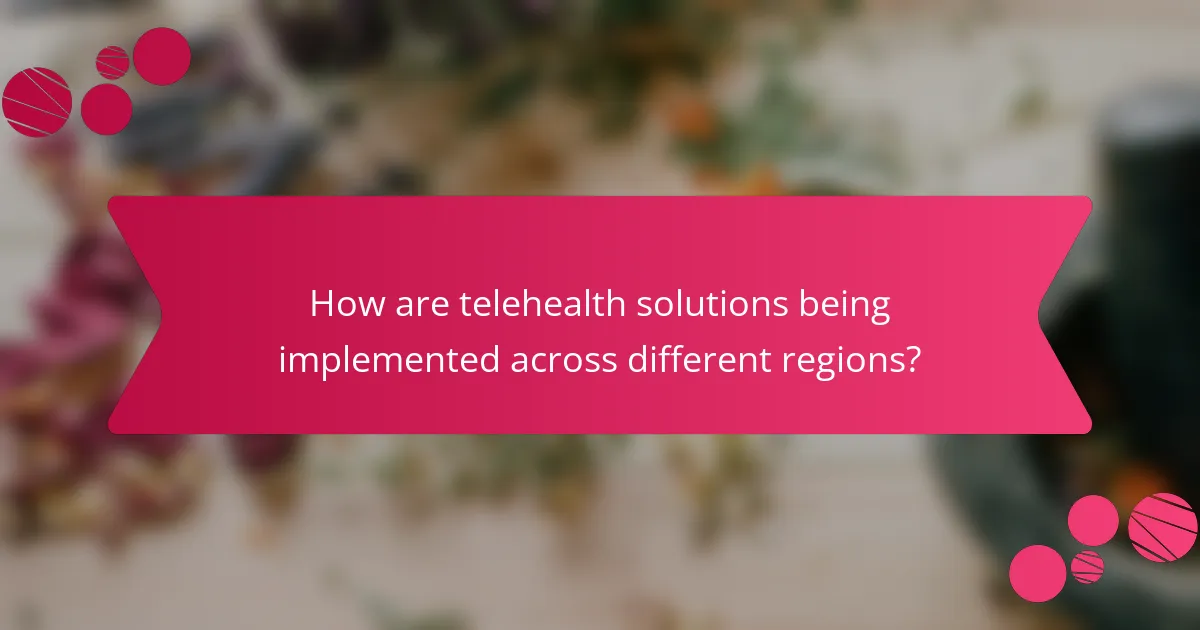Telehealth solutions for reproductive health enhance accessibility and convenience while addressing privacy concerns. This article explores the benefits of telehealth, the challenges it faces, and future trends shaping its adoption. Key metrics will be highlighted to evaluate effectiveness and ensure quality care. Additionally, best practices for secure communication and patient engagement will be discussed.

What are the main benefits of telehealth solutions for reproductive health?
Telehealth solutions for reproductive health offer increased accessibility, convenience, and privacy. They enable patients to consult healthcare providers from home, reducing travel time and associated costs. Telehealth also enhances continuity of care through regular follow-ups and monitoring, particularly for those with chronic conditions. Additionally, it can improve health literacy by providing easier access to educational resources.
How do telehealth solutions improve access to reproductive health services?
Telehealth solutions significantly enhance access to reproductive health services by removing geographical barriers and offering convenience. Patients can consult healthcare providers from their homes, which is particularly beneficial for those in remote areas. Telehealth also allows for greater privacy, encouraging individuals to seek care without the stigma often associated with reproductive health issues. As a result, it increases overall engagement with healthcare services, leading to better health outcomes. Furthermore, telehealth can streamline appointment scheduling and reduce wait times, making reproductive health services more accessible to a broader population.
What cost savings can be realized through telehealth for reproductive health?
Telehealth for reproductive health can lead to significant cost savings through reduced travel expenses, lower overhead for healthcare facilities, and decreased patient wait times. Telehealth eliminates the need for physical visits, allowing patients to access care from home. A study found that telehealth services can reduce costs by up to 30% for reproductive health consultations. Additionally, telehealth can improve access to specialists, which may further decrease overall healthcare costs.
How do telehealth solutions enhance patient privacy and confidentiality?
Telehealth solutions enhance patient privacy and confidentiality through secure communication channels and data encryption. These technologies reduce the risk of unauthorized access to sensitive health information. Additionally, telehealth platforms often comply with regulations such as HIPAA, ensuring stringent privacy protections. As a result, patients feel more comfortable discussing reproductive health issues, leading to improved healthcare outcomes.

What challenges do telehealth solutions face in reproductive health?
Telehealth solutions in reproductive health face challenges such as limited access to technology, privacy concerns, and varying state regulations. These barriers can hinder effective communication between providers and patients. Access disparities affect low-income populations, leading to unequal care. Privacy issues arise from sensitive health information, raising fears of data breaches. Additionally, inconsistent regulations across states complicate service delivery and provider licensing, impacting telehealth adoption and effectiveness.
What technical barriers do users encounter with telehealth platforms?
Users encounter several technical barriers with telehealth platforms, including connectivity issues, software usability challenges, and data security concerns. Connectivity problems can arise from unreliable internet access, which affects video quality and session stability. Usability challenges often stem from complex interfaces that may not be intuitive for all users, particularly older adults. Data security concerns include fears about privacy and the protection of sensitive health information. Addressing these barriers is crucial for improving user experience and ensuring effective telehealth services in reproductive health.
How do regulatory issues impact telehealth services for reproductive health?
Regulatory issues significantly impact telehealth services for reproductive health by creating barriers to access and compliance challenges. Laws vary widely by region, affecting service delivery and patient privacy. Providers must navigate complex regulations, which can limit the scope of services offered. For example, restrictions on prescribing certain medications via telehealth can hinder effective treatment options. As a result, inconsistent regulations may lead to disparities in care quality and availability across different states or countries.
What are the limitations of telehealth in addressing complex reproductive health issues?
Telehealth has limitations in addressing complex reproductive health issues due to factors like inadequate physical examinations, limited provider-patient interaction, and challenges in managing multifaceted conditions. These issues can hinder accurate diagnosis and treatment. Additionally, telehealth may not adequately support the emotional and psychological aspects of reproductive health, which often require in-person support. Access to technology and internet connectivity can also pose barriers for some patients, limiting the effectiveness of telehealth solutions.

How are telehealth solutions being implemented across different regions?
Telehealth solutions are being implemented across various regions through innovative platforms and local partnerships. These solutions enhance reproductive health access, especially in underserved areas.
Regions like North America leverage advanced technologies for virtual consultations, while Europe focuses on regulatory frameworks to ensure data privacy. In developing regions, mobile health applications increase outreach and education.
Challenges include inconsistent internet access and varying levels of healthcare infrastructure. Future trends may involve integrating artificial intelligence for personalized care and expanding telehealth services to include more comprehensive reproductive health options.
What unique adaptations have been made for telehealth in urban vs. rural settings?
Telehealth adaptations for urban and rural settings differ significantly. Urban areas often have advanced technology infrastructure, enabling high-speed internet and diverse service options. Rural settings face challenges like limited internet access and fewer healthcare providers, prompting tailored solutions such as mobile clinics and asynchronous communication methods. Urban telehealth frequently utilizes video consultations, while rural telehealth may prioritize telephone consultations due to connectivity issues. These adaptations aim to improve access to reproductive health services, addressing unique challenges in each environment.
How do cultural attitudes influence the adoption of telehealth for reproductive health?
Cultural attitudes significantly influence the adoption of telehealth for reproductive health by shaping perceptions and acceptance. Societal norms, stigma, and education levels affect individuals’ willingness to utilize these services. For instance, in cultures where reproductive health topics are taboo, telehealth may offer a more private and accessible option. However, resistance may arise from traditional views on healthcare delivery and gender roles, impacting adoption rates. Understanding these cultural dynamics is essential for tailoring telehealth solutions that resonate with diverse populations.

What are the latest trends in telehealth solutions for reproductive health?
Telehealth solutions for reproductive health are increasingly leveraging technology to improve accessibility and patient engagement. Current trends include the use of mobile health applications, virtual consultations, and remote monitoring tools. These innovations enhance patient education and support, enabling timely interventions. Additionally, the integration of artificial intelligence is personalizing care, while data analytics is improving outcomes. Challenges remain, such as ensuring data privacy and addressing disparities in access. The future of telehealth in reproductive health promises greater convenience and improved patient experiences.
How is artificial intelligence shaping telehealth services in reproductive health?
Artificial intelligence is enhancing telehealth services in reproductive health by improving accessibility and personalization. AI-driven platforms offer tailored health recommendations, enabling patients to receive customized care remotely. These technologies can analyze patient data, predict health outcomes, and recommend appropriate interventions. Additionally, AI helps streamline administrative tasks, reducing wait times and increasing efficiency in telehealth consultations. As a result, reproductive health services become more responsive and patient-centered, addressing unique needs effectively.
What role do mobile applications play in telehealth for reproductive health?
Mobile applications significantly enhance telehealth for reproductive health by providing accessible, confidential, and timely care. They facilitate remote consultations, enabling patients to connect with healthcare providers without geographical constraints. Mobile apps can track menstrual cycles, manage fertility, and provide educational resources, promoting informed decision-making. Additionally, they often include features for medication reminders and symptom tracking, improving adherence to treatment plans. As a result, mobile applications play a crucial role in empowering individuals to manage their reproductive health effectively.

What are the key metrics for evaluating the effectiveness of telehealth solutions?
Key metrics for evaluating telehealth solutions include patient satisfaction, access to care, clinical outcomes, and cost-effectiveness. These metrics ensure that telehealth effectively meets reproductive health needs.
| Metric | Description | Importance |
|———————-|————————————————–|—————————————|
| Patient Satisfaction | Measures user experience and comfort levels | Indicates service quality |
| Access to Care | Evaluates availability and reach of services | Assesses equity in healthcare access |
| Clinical Outcomes | Analyzes health improvements post-telehealth | Determines effectiveness of interventions |
| Cost-Effectiveness | Compares costs against traditional methods | Evaluates financial viability |
How do patient satisfaction scores reflect the success of telehealth services?
Patient satisfaction scores are crucial indicators of telehealth service success. High scores reflect effective communication, convenience, and quality of care in reproductive health. Telehealth enhances access, allowing patients to receive timely support while minimizing barriers. Consistent positive feedback can drive improvements and innovations in service delivery, shaping future trends in reproductive health care.
What outcome measures are important for assessing reproductive health through telehealth?
Key outcome measures for assessing reproductive health through telehealth include patient satisfaction, access to care, clinical outcomes, and adherence to treatment plans. These measures help evaluate the effectiveness of telehealth interventions. Additionally, unique attributes such as the ability to monitor real-time data and rare attributes like the integration of mental health support enhance reproductive health assessments.

What best practices should be followed when using telehealth for reproductive health?
To effectively use telehealth for reproductive health, follow these best practices: ensure secure communication, maintain patient privacy, utilize reliable technology, provide clear instructions, and foster patient engagement. These practices enhance care quality and patient satisfaction.
1. Ensure secure communication: Use encrypted platforms to protect sensitive information.
2. Maintain patient privacy: Adhere to HIPAA regulations and local laws.
3. Utilize reliable technology: Choose platforms with high uptime and user-friendly interfaces.
4. Provide clear instructions: Guide patients on how to access services and prepare for appointments.
5. Foster patient engagement: Encourage open dialogue and feedback to improve services.
How can providers ensure effective communication with patients in telehealth settings?
Providers can ensure effective communication with patients in telehealth by utilizing clear language, active listening, and technology that enhances interaction. Establishing a rapport through empathy fosters trust. Regular follow-ups and feedback mechanisms improve understanding and satisfaction. Tailoring communication styles to individual patient needs enhances engagement.
What common mistakes should be avoided when implementing telehealth solutions?
To avoid common mistakes when implementing telehealth solutions for reproductive health, focus on user experience, data security, and integration. Neglecting these aspects can lead to decreased patient engagement and compromised privacy. Ensure that platforms are user-friendly and accessible to all demographics. Prioritize compliance with regulations like HIPAA to safeguard sensitive information. Lastly, integrate telehealth systems with existing healthcare infrastructure to streamline workflows and enhance service delivery.
